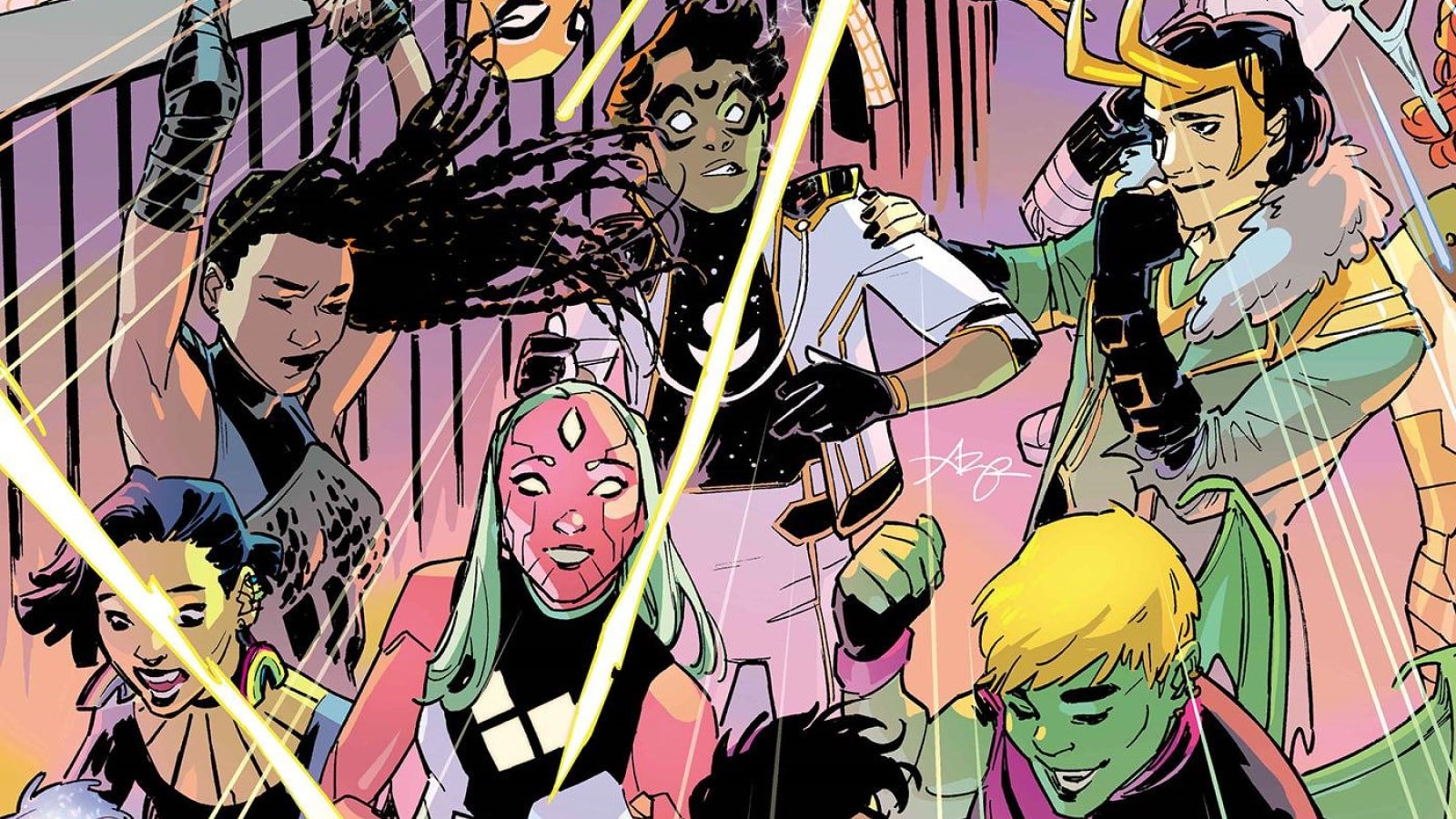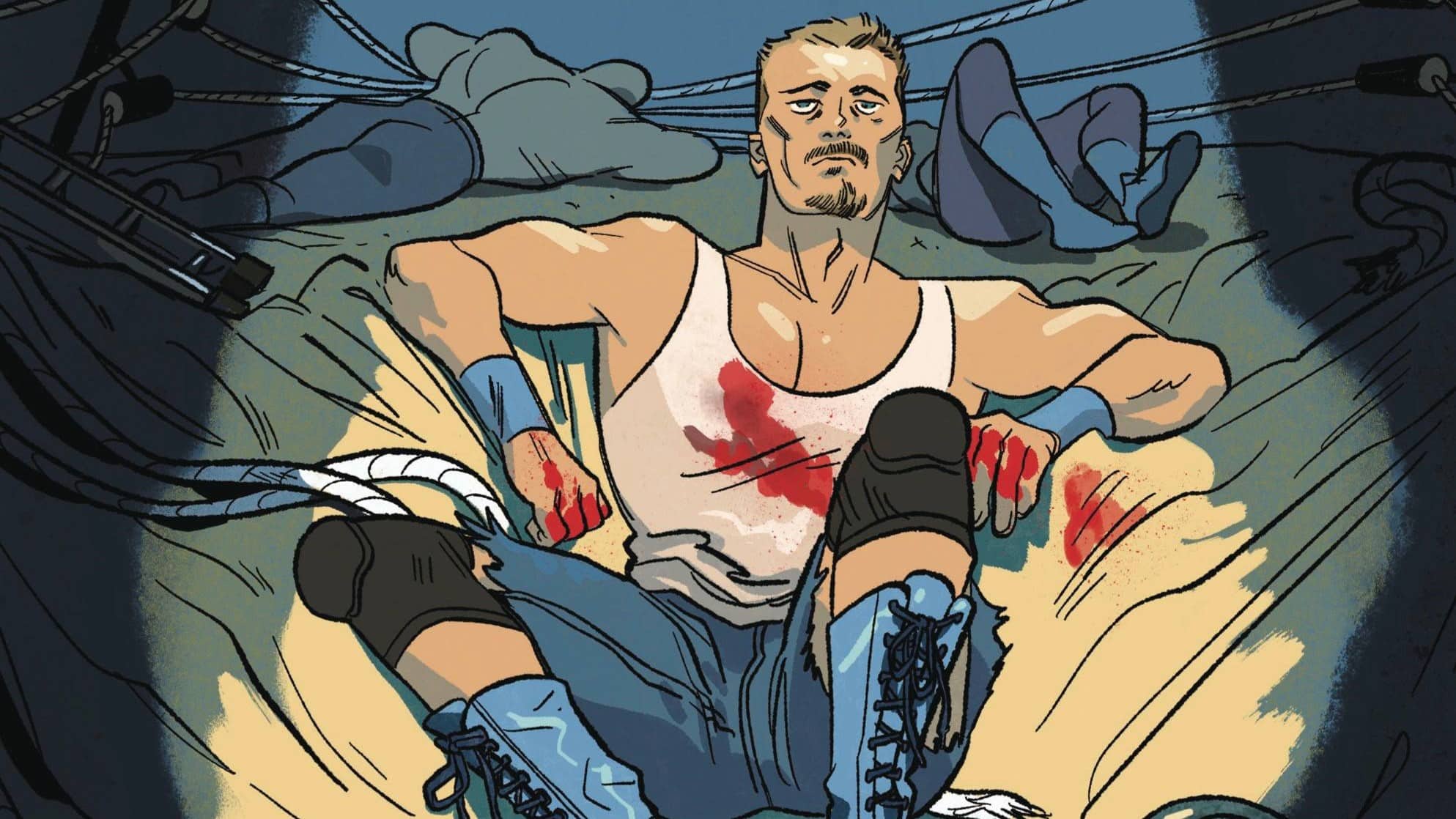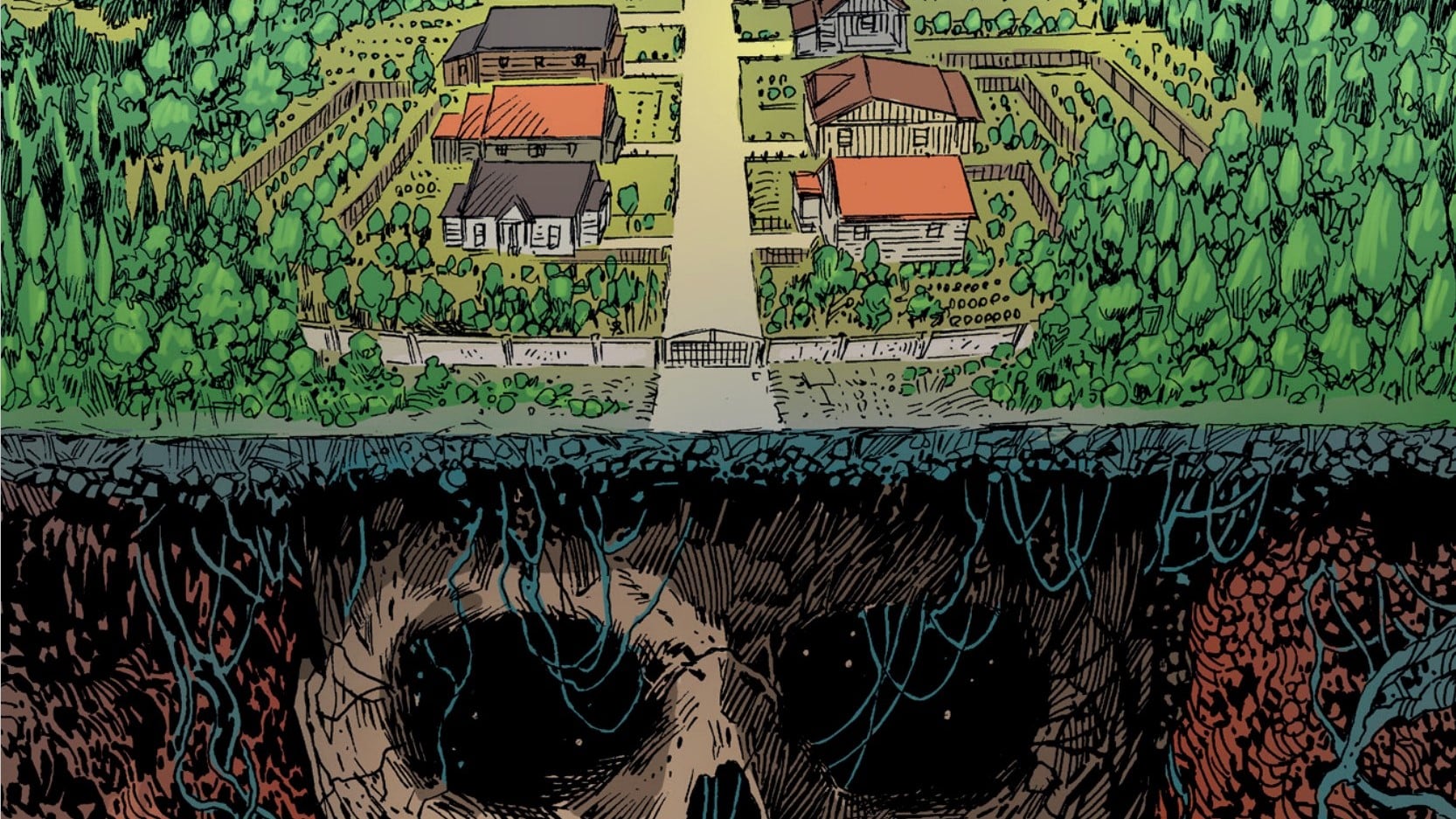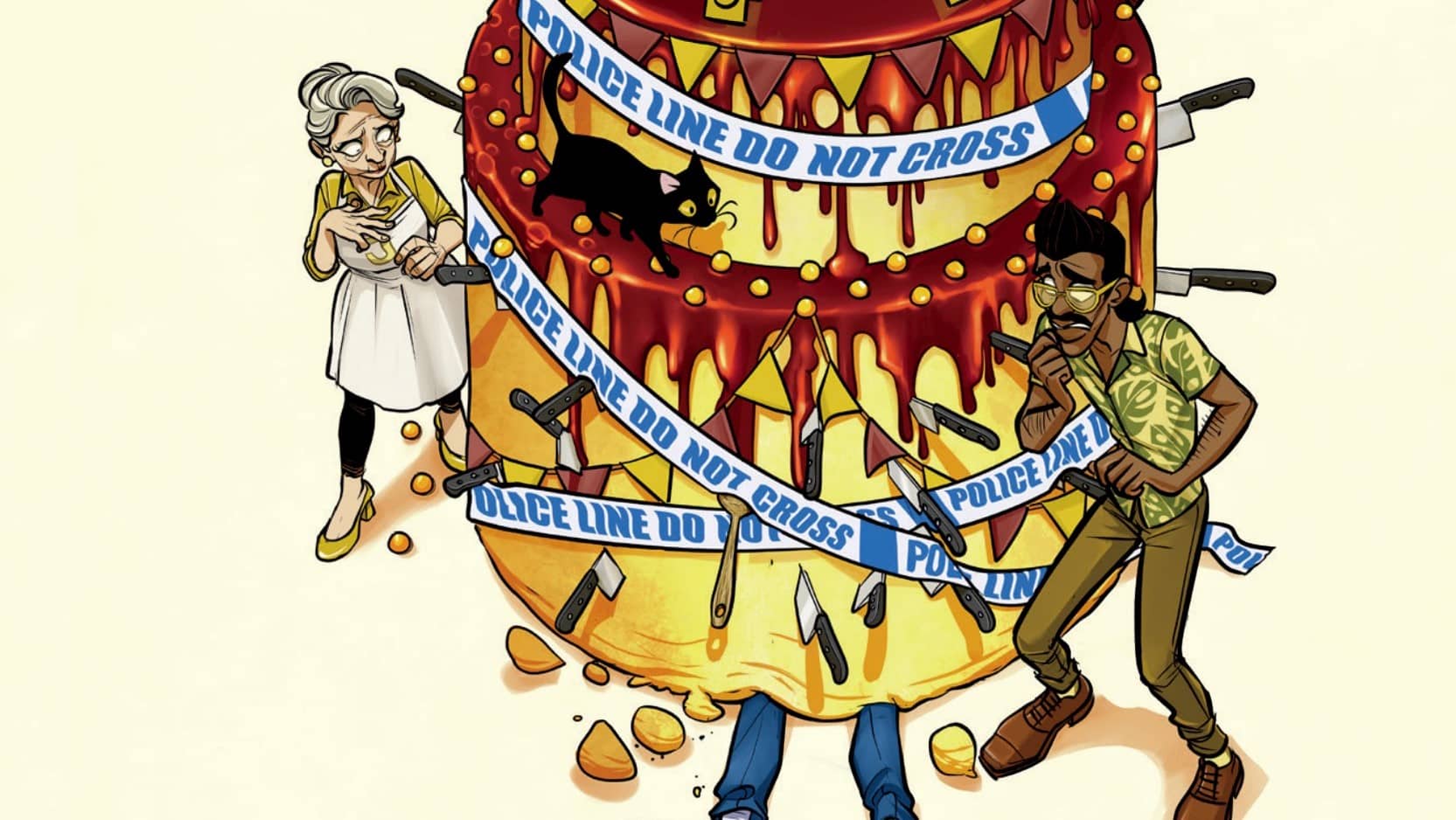We Only Find Them When They’re Dead #1 is the new sci-epic from writer Al Ewing (Immortal Hulk), artist Simone Di Meo (Mighty Morphin Power Rangers), colorist Mariasara Miotti and letterer AndWorld Design. It tells the story of one man’s unending quest through space to discover the truth. Oh, and it’s also about harvesting giant robot corpses!
Always Beautiful

Zach Rabiroff: Eight bells and all is well, Andrea. The keyboard is sharp and ready for the work. The fingers are ripe and ready to type. Yes, we’re all set to review the debut issue of Al Ewing and Simone Di Meo’s hotly anticipated space saga We Only Find Them When They’re Dead, which debuts this week courtesy of BOOM Studios.
Those who have read my past work, or engaged in a conversation with me on any unrelated topic lasting longer than several seconds, will know I’m an avowed Al Ewing connoisseur. He’s easily one of my favorite writers in the field today, with his heady, high-concept science fiction ideas and deeply felt commitment to character work and emotional development. So I’ve been looking forward to this big break onto the creator-owned scene for quite some time, and I’m excited to dig into it with you. Welcome aboard this autopsy ship!
Andrea Ayres: It’s noon then, is it Zach? First, a little bit more on what those eight bells might portend. Eight bells ring at 4, 8 and 12. Eight bells also signify the end of a sailor’s watch, in addition to being used for burials at sea. OK, let’s move forward to a rundown of the first issue.
Captain Malik takes his crew aboard the ship named the Vihaan II* to harvest vital resources from massive robot corpses in space (as one does). Why? Because these corpses contain materials necessary to sustain human life. It would appear that humans have plundered resources everywhere else, or so that is the implication. That would appear to be some pretty straightforward sci-fi space drama stuff, right? Come on now. Nothing with Ewing’s work is ever that simple, and this is no different.
There’s an early indication of something slightly amiss when Malik reminds the ship’s engineer, Jason Hauer, to mind what they say because the ship has ears. What’d you think about them apples? Also, would love to know your impression of the opening pages here.
*Note of trivia: Vihaan appears to translate from the Hindu masculine meaning “dawn, morning.”
ZR: Phew! Well, let’s talk about those opening pages, because the cold open (immediately preceding one of the more awesome two-page title drops I’ve seen in a long while) might actually be my favorite part of this entire debut issue. It’s a single-page flashback, set some four decades before the rest of the story, and it consists of a short dialogue between a younger version of our captain and protagonist Malik and his parents, on what turns out to be a pretty meaningful and traumatic day of his young life.
There are so many world-building implications packed into a few short word balloons here. First: These voyagers are the product of a society in its twilight, which has dramatically overtaxed its resources and needs to be bailed out by outside intervention. Second: That intervention has arrived, as if by literal deus ex machina, in the form of enormous gods on the fringe of the solar system. And third: Those gods are – ain’t that always the luck? — dead, and it’s their bodies, rather than their spirits, that are providing the fuel for what remains of civilization. So there’s our fantastically bizarre premise in a nutshell, and to my mind, this little sequence hits harder than anything that follows it in the issue.
It’s the fact that everything significant is happening just off-screen, while Di Meo’s camera stays pointed at the faces of the characters. The fading planetary society, the mining industry to which this family has belonged for generations, the looming body of the deceased divinity just ahead: All of it remains mysterious, ineffable and left to our feeble imaginations. It’s not so much a mission statement for the series as an emotional statement, and it’s something I hope the rest of this story can recapture.
AA: You’ve captured that beautifully there, Zach. It’s difficult to say just how gorgeous the image of the first god is. Di Meo’s art, coupled with Mariasara Miotti’s colors, does a lot to take the breath away. Speaking of getting a look at our first god, it’s much more disconcerting than I thought it would be. Specifically the act of seeing a ship slice into the mouth, ripping away parts of the face to expose the teeth underneath. The god is nothing but meat and protein, no vital resources to mine here. Naturally, I read into this.
I bring my own religious upbringing, however brief, to the table. Many faiths create religious entities in their likeness, perhaps to identify with them more. Still, these deities loom large over our existence. We look to them for answers, for help, perhaps as a resource to be plundered? That the breaking of this divine being is work, that we see the ship’s laser slice through the face is definitely reflecting something about humanity, and it’s not altogether good. What’d you think of our first god sighting?
ZR: I think you really captured the, uh, meat of what makes this sequence work on a truly unsettling level, Andrea. It’s those visuals of close-up body parts being sliced away, one by one. The gods – if, indeed, gods they really are – are nothing more to this society than skin and bones. Humanity received a gift from on high, and rather than gaze upward toward the stars to give thanks, they looked down at their cars and air conditioning units and who knows what else, and thought only of ways to keep them going. There’s something so tragically sordid about the quiet inability of these people to engage with divinity, and it makes Malik’s revelation of his real quest, to see a live god at last, seem all the more vital.
Just Simple

ZR: One of the clever things about this issue is the way that, despite the grand themes and implications of a broader universe, the comic is really structured as a bottle episode, contained within the cabin of the Vihaan II. It allows Ewing to let us see the action and the universe entirely through the eyes of our cast for the series (or at least for this opening arc): Malik, coroner Ella Hauer, engineer Jason Hauer and Quartermaster Alice Wirth. Or at least it’s notionally clever, although I’m not sure it actually worked all that well in practice.
Because the bulk of the issue is devoted to a single, tense run-in with galactic authorities, there’s little room here for character-building dialogue beyond hectic, sometimes snappy banter between crew members. I’d have liked to see at least a little more sketching of individual personalities over the course of the issue, if only through their speech to one another. The model here (and maybe this is what Ewing was aiming for) is something like the film Das Boot, where the claustrophobia of a crew stuck together on a submarine for months on end manages to distill and intensify their relationship. But then again, maybe I just need to give it all more time. But what about you? What did you think of our first glimpse at the characters we’ll be following?
AA: I tend to agree with you. It feels frenetic, but frenetic enough to warrant the lack of dialogue? I’m not entirely sure. I do know that, and this is because we’ve heard the most from the Captain, I find myself most interested in what his whole deal is. The history between Malik and Paula Richter sure seems, erm, intense.
“Never forget where you came from. I know who you are.”
“Oh, it’s quite simple, Jason. She killed my parents.”
Killing parents does tend to cool a relationship with someone. I’m also intensely interested in the scale of authoritarianism that seems to rule their lives. Malik reminds his crew several times that the ship has ears. It seems almost to the point of paranoia? There’s definitely something there. The only time the ship’s ears are not operational is when they are at warp. Definitely something to keep in mind.
Of note, one of the other ships we are introduced to in this issue is named the Pavonis. Pavonis comes from the Latin meaning “Peacock” but is also the name of a volcano on Mars. (In the voice of The Dude) Everything’s so layered, mannnnnnn.
ZR: I know you mentioned Miotti’s colors earlier, and we’ve both complemented Di Meo’s pencils (which really capture the enormity of these unnerving images brilliantly), but I’ve got to be frank and say the art is really the aspect of this comic that was least successful to my mind. The problem isn’t the linework, necessarily, so much as the storytelling, and a big part of that comes down to the choices of coloring palette.
It’s easy for readers to overlook the importance of colors in delineating clear distinctions between events, and lines of motion between characters and panels, but Miotti’s choice to use the same variety of teal, purple and orange throughout the issue has the unintended effect of blurring the action together, erasing the divisions between distinct scenes and compressing all the action into a single, somewhat confusing blur. On the other hand, part of the fault may, alas, lie with Ewing here.
In times past, this is a writer who has, if anything, tended to pack too much into his comics, loading his issues with a frantic overflow of ideas that would make Jack Kirby blush. Here, in an admirable effort to take his time and build the atmosphere slowly by degrees, it may be that he has overcorrected, and simply decompressed this opening chapter beyond what it can bear. But that’s my take on the visual and narrative stylings at work. What about you?
AA: Yo. I think you nailed it. Perhaps what is throwing me off with respect to the colors is that they do not lend themselves to the atmosphere Ewing is going for here? While I have a personal preference toward the palette Miotti is using, I’m not sure if they always match what’s happening in the script. Perhaps the incongruence is meant to alert us to something, although what that something is, we may not know?
As you said, it seems to compress the action into a single confusing blur, and that may indeed be the point? Though I may be reading too charitably into things. There is a softness to the colors, lines, to almost everything. Where we see more jaggedness is when the ship is slicing into the god’s mouth (Page 9). Across the board, action sequences or moments of tension are punctuated by similar line configurations. They appear to be jutting into and overlapping. I think the colors are meant to complement this feeling.
Madness of Men

ZR: Among other things Ewing is doing here, he’s building an interesting parallel to Herman Melville’s Moby-Dick in ways that go beyond the obvious. Malik is obviously our Ahab here, his missing eye – lost, can we presume, in the same attack that took the lives of his parents? – standing in for a missing leg. Even the captain’s name is a wink: “Malik” is Arabic for “king,” and Melville’s Ahab was named after the similarly driven king of Israel. But it goes much deeper than that.
Both stories take place against the backdrop of a society whose golden age has quietly passed. Even its inhabitants aren’t ready or willing to come to terms with that new reality. Just as the systematic over-hunting of sperm whales had turned sailing voyages of a few days into years-long trips to sea, so too do we learn here that crews like the Vihaan II have been traveling farther and farther into the fringes of space to find remaining gods to mine. It carries some truly unsettling implications about the society this crew left behind: What does the planet look like, after centuries of what appears to be unchecked capitalistic growth?
It’s clear that the corporate-governmental authorities have enough reach to enforce bureaucratic regulations even this far out in the cosmos, so whatever money and power is propping up officers like Paula Richter must be living comfortably indeed. And that sets up our crew very nicely as dissidents against the capitalist state – a zeitgeisty position for them to be in, in this year 2020.
AA: Listen, Zach, if you are just going to sit here and say all the good things, what will there be for me to do? I’d love to touch on what you’ve said about the element of systematic over-hunting clearly at play here. I think the panel spread on Page 13 perfectly encapsulates the feeling of routine. The layout here gives us a sense that there is nothing new to this process of mining a corpse, nothing interesting. It is merely business as usual. The straightforward panel progression, especially in contrast to the layout of the rest of the issue, stands apart. It’s definitely doing so for a reason.
Alice says the harvesting of meat is like a ballet, to which Malik says, “No, but it could be.” For whatever reason, this response strikes me. How could it be like a ballet?
One of the materials mentioned is “devonium.” Apparently it has the ability to be used in weapons, so yet another indication this culture is at war. The Devonian period on Earth was 416 to 339 million years ago. According to National Geographic, it is known as the “Age of Fishes,” which definitely gives further bolstering to the many ships and sea references. Of note, the Devonian period ended in a mass extinction from (though this is speculation) either global cooling, greenhouse gas or asteroid impact.
My money is on the climate change bits, kiddos. It feels so spot on to have the government be hyper-focused on policing these ships while the rest of their universe fades into oblivion. 2020 vibes all the way.
ZR: It’s in the grand tradition of science fiction, really: constructing a future unfamiliar in its superficial veneer, but, beneath the surface, just an extension of our own world taken to a logical and uncontrolled extreme. So not only do we have the overtaxing of resources and the (probable) degradation of the environment, but also the unchecked expansion of private industry at the expense of the common person: “These are desperate times for desperate souls,” says Malik to his crew, “New corporate fleets, ready to steal whatever gold is left. Muscle us out one by one.” It’s like the latter days of the California Gold Rush when the flowing rivers of gold dust had given out, and independent prospectors had no choice but to turn to virtual servitude for monied investors and corporate interests. But vihaan means “sunrise” or “dawning,” and these shipmates are chasing what seems to be the last chance at a new dawn: a quest not, like Ahab, to kill a god, but to save them. And in so doing, they just might be able to redeem the sins of an entire culture, or an entire world.
Final Thoughts

ZR: There’s a lot to digest here, and we’re only on the first leg of a long space race, but I think it’s safe to say that this is a promising start. Setup issues are tough, and I’d be lying if I didn’t admit that I expected a little bit more from such a sterling creative team making a very high-profile creator-owned debut. A little more clarity to the storytelling and colorwork, and a little more time spent conveying personalities and relationships before moving on to the action, would have gone a long way toward making this feel like a really classic first issue, rather than a mixed bag of potential. And yet, all that said, this comic has what Ewing comics always seem to have: a richness of ideas and evocative concepts that perch on the border between the horrific and the divine. That alone is worth the ticket price for this voyage, and I’m planning to stay on board until the godhead comes into view.
AA: Yep. It’s certainly a promising start, and I look forward to meeting a live god. Malik seems to be speaking to the reader at the end of the issue when he says “in three days time, we’ll see a live one.” There is also a lens flare on the bottom of the page. I don’t recall seeing it anywhere else? Lens flares happen when the camera is reflecting a very bright light source? Are we watching Malik? If not us, who?
OK, one more thing about Malik which may be of note to our readers. Pirates wore eye patches not because they had something wrong with their eyes, but rather to help them see better in the dark.
As you said, because the action occurs so early, we don’t really have a sense of tone or personality for these characters. It made it a little difficult to imagine their interactions with one another in my brain space. I’ll definitely accompany you on these murky waters, though I know nothing about ships or seafaring. Thankfully, I come equipped with Google. To the seas!






